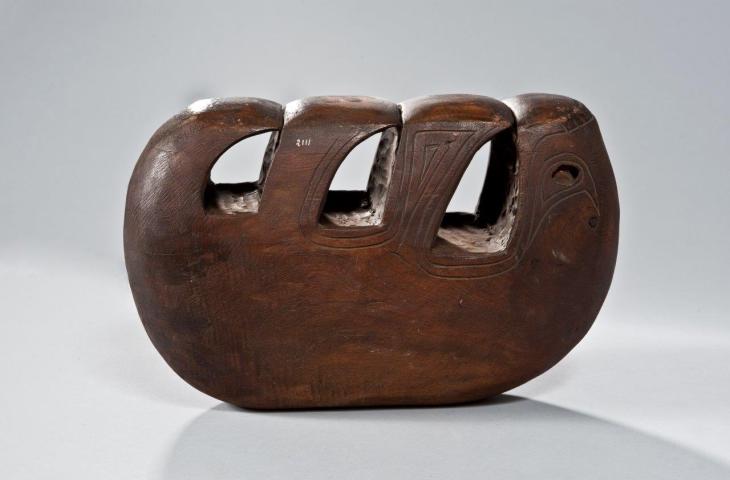May 2022
Fig.1

Lunuwat, Copy of an instrument at the Rijks Ethnographisch Museum (Leiden), New Ireland (Papua New Guinea), 1901, inv. 2111
Probably towards the end of October 1897, during a visit by Johannes Schmeltz (curator of the Rijks Ethnographisch Museum in Leiden), Victor-Charles Mahillon, first curator of the Brussels Instrumental Museum, became aware of a Melanesian musical instrument whose existence he had never suspected before, either from the point of view of its construction or of the way it was played: the lunuwat, a monoxyle friction idiophone, only documented in the north of New Ireland in Papua New Guinea, in the so-called malanggan cultural area.
Extraordinarily for Victor-Charles Mahillon, the configuration of this instrument fitted fully into the category - elaborated on a largely theoretical basis - of "autophone instruments rubbed by the finger or the bow" of his instrumental classification published in 1880 and updated in 1893 (class I, branch C, section a). It is easy to understand the interest that the curator of the Brussels Instrumental Museum could have had in this instrument if one considers that until then he had only been able to illustrate this category with the glass harmonica and the iron violin, two composite instruments, rather late and otherwise marginal from a traditional point of view. Thus, in his eyes, this discovery could constitute the historical validation of an instrumental category that had remained largely empty and, consequently, the legitimation of his entire classification system.
Discovering this instrument under the terminology "Kulepaganeg" given by Otto Finsch in 1888/1893 in the catalogue of his collection (no. 594), taken up by Johannes Schmeltz in 1896 in the description of an instrument kept in Hamburg, Victor-Charles Mahillon did not cease to document himself on this instrument, and then, in November 1899, took the first steps to obtain a specimen. It is no doubt not entirely coincidental that, faced with the immense difficulties involved in acquiring such a rare and distant instrument, he decided in July 1901 to travel from Brussels to Leiden where, it seems, he negotiated a copy of the specimen kept in the Rijks Ethnographisch Museum (inv. RV-316-147). The facsimile was made by a certain C. Knaufl - probably a restorer at the museum - and arrived in Brussels in December 1901 (inv. mim 2111). It was only much later, in February 1908, that Victor-Charles Mahillon finally managed to obtain an original copy of this instrument (inv. mim 3012 - now unlocated), sent to Brussels from German New Guinea by Governor Albert Hahl through the intermediary of the Ministry of Foreign Affairs and the Belgian Consulate in Melbourne.
Characterised by three blades carved from a block of wood forming a tail, legs and head, the lunuwat is decorated to emphasise its zoomorphic nature: pig and/or bird. It is usually played in an upright position - or on the arm for the smallest models - by rubbing the resin-coated hands, the blades thus set in vibration generating plaintive and piercing sounds. Exclusively used by initiated men and traditionally forbidden to women, this instrument is intimately linked to funeral rites during which its unique sound seems to have been perceived as a manifestation of the deceased, or, as the case may be, of a bird acting as an intermediary between the two worlds. The instrument is also documented in association with the complex Malanggan ceremonies - now famous for their teratomorphic sculptures - which, although always linked to the memory of a dead person, involve many dimensions of social life. However, it does not appear to have been a Malanggan object per se.
Only about fifty copies of this instrument seem to have been preserved, either in museums or in private collections. As the instrument acquired by Victor-Charles Mahillon in 1908 can no longer be found in the collections of the MIM since the 1980s, it is the copy of the Leiden specimen made in 1901 by C. Knaufl that is presented here. Contrary to the traditional, strictly monoxyle construction, this facsimile was made in several parts, probably from a European wood: in fact, responding to the expectations of the client, it is above all the capacity of the instrument to produce a sound that was privileged during the copying.
Text: Fañch Thoraval